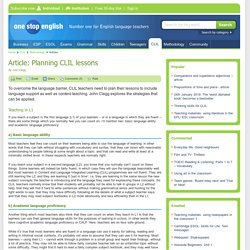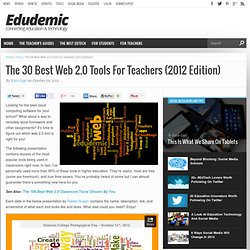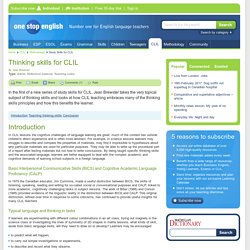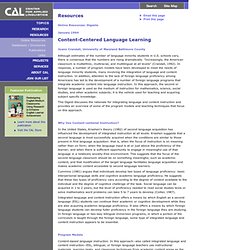

Oxford Webinar: Reading Plans for CLIL. Read on! Project 1 by Francesca Panza on Prezi. CLIL-CD > European Framework for CLIL Teacher Education. Focus on Content-Based Language Teaching. What is CLIL? CLIL stands for Content and Language Integrated Learning.

It refers to teaching subjects such as science, history and geography to students through a foreign language. This can be by the English teacher using cross-curricular content or the subject teacher using English as the language of instruction. Both methods result in the simultaneous learning of content and English. If you teach EMI (English as a Medium of Instruction), LAC (Language Across the Curriculum), CBI (Content-based Instruction) or CBLT (Content-based Language Teaching; if you work in Bilingual Education; if you’re a subject teacher working through the medium of a foreign language, or a language teacher bringing in content into your English lesson, you work within the area of Content and Language Integrated Learning. (Marsh, D. 2002. “We would like to apologise for the temporary disappearance of the teacher’s corner and the repeat upload of a few articles, which you may have already read.
(Graddol D. Core CLIL Activators. Extensive reading. The reading skill is most often taught by close study of short passages followed by analysis of language.

Extensive reading: An alternative approach Aims of extensive reading The characteristics of an extensive reading approach Motivation The teacher's role Conclusion The value of this intensive reading procedure, with its focus on the teaching of discrete reading skills has been questioned by some, who claim that teaching students reading strategies does not necessarily make them better readers. It is widely believed that people become good readers through reading, and that learning how to read should mean a focus of attention on the meaning rather than the language of the text. Extensive reading: An alternative approach Another model for teaching reading exists. This is an 'extensive reading approach' and involves students reading long texts or large quantities for general understanding, with the intention of enjoying the texts.
CLIL Lesson Plans. Article: Planning CLIL lessons. By John Clegg To overcome the language barrier, CLIL teachers need to plan their lessons to include language support as well as content teaching.

John Clegg explores the strategies that can be applied. Teaching in L1 If you teach a subject in the first language (L1) of your learners – or in a language in which they are fluent – there are some things which you normally feel you can count on. I’ll mention two: basic language ability and academic language proficiency. a) Basic language ability Most teachers feel they can count on their learners being able to use the language of learning; in other words that they can talk without struggling with vocabulary and syntax; that they can listen with reasonable understanding to people talking at some length about a topic; and that can read and write at least at a minimally skilled level.
The 30 Best Web 2.0 Tools For Teachers (2012 Edition) Looking for the best cloud computing software for your school?

What about a way to remotely store homework and other assignments? It’s time to figure out which web 2.0 tool is right for you! The following presentation contains dozens of the most popular tools being used in classrooms right now. In fact, I’ve personally used more than 90% of these tools in higher education. They’re useful, most are free (some are freemium), and true time-savers. See Also: The 100 Best Web 2.0 Classroom Tools Chosen By You Each slide in the below presentation by Rafael Scapin contains the name, description, link, and screenshot of what each tool looks like and does. Edudemic’s Recommendations If you’re looking to try out some of these tools, here are the top 5 tools we recommend you try out (if you haven’t already). Slideshare - Get the credit and audience you deserve for your presentations!
Scoop.it - A stellar social bookmarking service that is being used by a ton of teachers right now. Thinking skills for CLIL. By Jean Brewster In the first of a new series of study skills for CLIL, Jean Brewster takes the very topical subject of thinking skills and looks at how CLIL teaching embraces many of the thinking skills principles and how this benefits the learner.

In CLIL lessons the cognitive challenges of language learning are great; much of the content lies outside children's direct experience and is often more abstract. For example, in science lessons learners may struggle to describe and compare the properties of materials, may find it impossible to hypothesize about why particular materials are used for particular purposes.
They may be able to write up the procedural part of a report after testing materials but not how to write conclusions. Article: Skills for CLIL. In this article John Clegg outlines the language and learning skills which a learner learning a subject through the medium of English as a second language (L2) requires. 1.

Introduction. CLIL Principles. Content-Centered Language Learning. Resources Online Resources: Digests January 1994.

CLIL-CD Home. CLIL for the Knowledge Society (David Marsh / Eurydice)
6. CLIL Magazine - Clil magazine. Università degli Studi di Foggia. Oxford Webinar: Reading Plans for CLIL.